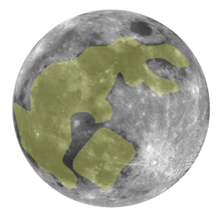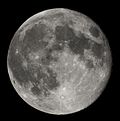- Moon rabbit
-
Moon rabbit 
The image of a rabbit delineated on moon's surface Chinese name Traditional Chinese 月兔 Simplified Chinese 月兔 Literal meaning Moon rabbit Transcriptions Mandarin - Hanyu Pinyin yuètù Cantonese (Yue) - Jyutping jyut6 tou3 Alternative Chinese name Chinese 玉兔 Literal meaning Jade rabbit Transcriptions Mandarin - Hanyu Pinyin yùtù Cantonese (Yue) - Jyutping jyuk6 you3 Japanese name Kanji 月の兎 Transcriptions - Romaji tsuki no usagi Korean name Hangul 달토끼 Transcriptions - Revised
Romanizationdal tokki The Moon rabbit, also called the Jade Rabbit, in folklore is a rabbit that lives on the moon, based on pareidolia that identifies the markings of the moon as a rabbit. The story exists in many cultures, particularly in East Asian folklore, where it is seen pounding in a mortar and pestle.[1][2] In Chinese folklore, it is often portrayed as a companion of the moon goddess Chang'e, constantly pounding the elixir of life for her; but in Japanese and Korean versions it is just pounding the ingredients for rice cake.
Contents
History
An early mention that there is a rabbit on the moon appears in the Chu Ci, a Western Han anthology of Chinese poems from the Warring States period, which notes that along with a toad, there is a rabbit on the moon who constantly pounds herbs for the immortals. This notion is supported by later texts, including the Imperial Readings of the Taiping Era encyclopedia of the Song Dynasty. Han Dynasty poets call the rabbit on the moon the Jade Rabbit or the Gold Rabbit (金兔), and these phrases were often used in place of the word for the moon. A famous poet of the Tang Dynasty period, Li Bai, relates how: "The rabbit in the moon pounds the medicine in vain" in his poem "The Old Dust."
Folklore
In the Buddhist Śaśajâtaka (Jataka Tale 316),[3] a monkey, an otter, a jackal, and a rabbit resolved to practice charity on the day of the full moon (Uposatha), believing a demonstration of great virtue would earn a great reward.
When an old man begged for food, the monkey gathered fruits from the trees and the otter collected fish, while the jackal wrongfully pilfered a lizard and a pot of milk-curd. The rabbit, who knew only how to gather grass, instead offered its own body, throwing itself into a fire the man had built. The rabbit, however, was not burnt. The old man revealed himself to be Śakra and, touched by the rabbit's virtue, drew the likeness of the rabbit on the moon for all to see. It is said the lunar image is still draped in the smoke that rose when the rabbit cast itself into the fire.
A version of this story can be found in the Japanese anthology Konjaku Monogatarishū, where the rabbit's companions are a fox and a monkey.
Similar legends occur in Mexican folklore, where people also identified the markings on the moon as a rabbit. According to an Aztec legend, the god Quetzalcoatl, then living on Earth as a man, started on a journey and, after walking for a long time, became hungry and tired. With no food or water around, he thought he would die. Then a rabbit grazing nearby offered herself as food to save his life. Quetzalcoatl, moved by the rabbit's noble offering, elevated her to the moon, then lowered her back to Earth and told her, "You may be just a rabbit, but everyone will remember you; there is your image in light, for all people and for all times."
Another Mesoamerican legend tells of the brave and noble sacrifice of Nanahuatzin during the creation of the fifth sun. Humble Nanahuatzin sacrificed himself in fire to become the new sun, but the wealthy god Tecciztecatl hesitated four times before he finally set himself alight to become the moon. Due to Tecciztecatl's cowardice, the gods felt that the moon should not be as bright as the sun, so one of the gods threw a rabbit at his face to diminish his light. It is also said that Tecciztecatl was in the form of a rabbit when he sacrificed himself to become the moon, casting his shadow there.
A Native American (Cree) legend tells a different variation, about a young rabbit who wished to ride the moon. Only the crane was willing to take him. The trip stretched Crane's legs as the heavy rabbit held them tightly, leaving them elongated as crane's legs are now. When they reached the moon Rabbit touched Crane's head with a bleeding paw, leaving the red mark cranes wear to this day. According to the legend, Rabbit still rides the moon to this day.
Modern references
- The moon rabbit was mentioned in the conversation between Houston and the Apollo 11 crew just before the first moon landing:[4]
Houston: Among the large headlines concerning Apollo this morning there's one asking that you watch for a lovely girl with a big rabbit. An ancient legend says a beautiful Chinese girl called Chang-o has been living there for 4000 years. It seems she was banished to the moon because she stole the pill of immortality from her husband. You might also look for her companion, a large Chinese rabbit, who is easy to spot since he is always standing on his hind feet in the shade of a cinnamon tree. The name of the rabbit is not reported.
Edwin "Buzz" Aldrin (LMP): Okay, we'll keep a close eye for the bunny girl.
- Kenneth Anger's film Rabbit's Moon, released in 1972, takes inspiration from the folklore of the moon rabbit.
- The American electronic music group Rabbit in the Moon gets its name from this legend.
- Usagi Tsukino (in Japanese, Tsuki no Usagi: "the moon's rabbit") from Sailor Moon is named after the legend.
- The character Reisen Udongein Inaba from Touhou Project is a moon rabbit escaped from the war between the Moon and the Earth.
See also
- Man in the Moon
- Mid Autumn Festival
- Tecciztecatl
- Three hares
References
- ^ The Great Hare.
- ^ Windling, Terri. The Symbolism of Rabbits and Hares.
- ^ Source: [1] (accessed: Saturday January 23, 2010)
- ^ Apollo 11 Technical Air-to-Ground Voice Transcription
External links
- Kazumaro, Kanbe. "Buddhist sayings in everyday life - Tsuki no Usagi". Otani University. 2005. Retrieved on July 25, 2007.(Japanese)
- Varma. C.B. "The Hare on the Moon". The Illustrated Jataka & Other Stories of the Buddha. 2002. Retrieved on July 25, 2007.
- 「與月為伴 愉閱中秋」, Taipei Public Library. 2006. Retrieved on July 25, 2007. (Chinese)
- Wood, Douglas - "Rabbit and the Moon"
The Moon Physical features 
Orbit Lunar surface - Selenography
- Near side
- Far side
- Lunar mare
- (List)
- Craters
- (List)
- Mountains
- Valleys
- South Pole – Aitken basin
- Shackleton crater
- Water
- Soil
- Peak of eternal light
- Space weathering
- Transient lunar phenomenon
Lunar science Exploration Other topics - See also Solar System
- Natural satellite
Categories:- Asian legendary creatures
- Chinese mythology
- Mythological rabbits and hares
- Moon myths
- Moon in fiction
- Jataka
Wikimedia Foundation. 2010.

